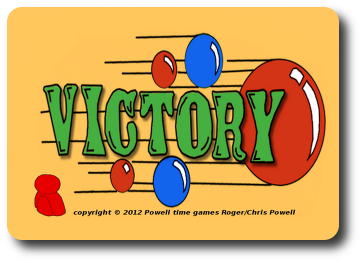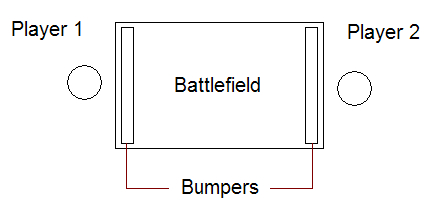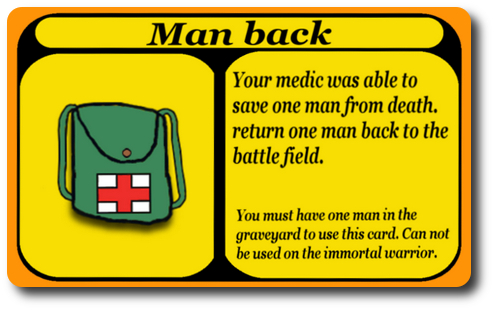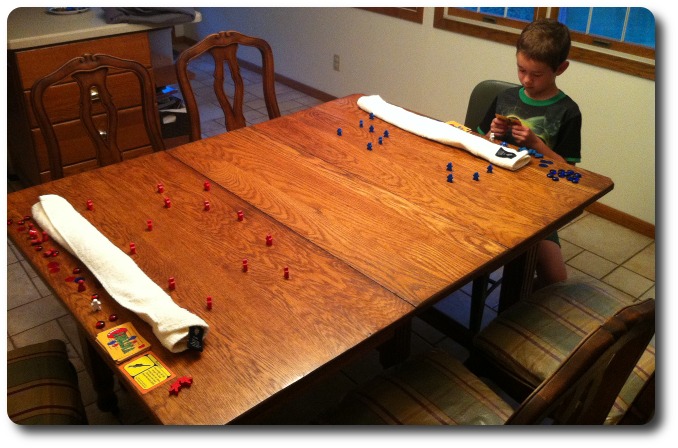
The Basics:
- For ages 7 and up (designer suggests 12+)
- For 2 players
- About 20 minutes to complete
Geek Skills:
- Reading
- Counting
- Hand/Eye Coordination & Dexterity
Learning Curve:
- Child – Easy
- Adult – Easy
Theme & Narrative:
- An abstract war takes place in front of the players, as they command their troops on the battlefield!
Endorsements:
- Gamer Geek rejected!
- Parent Geek approved!
- Child Geek approved!
Overview
The lines have been drawn and both armies now stand and face each other. Their generals stand behind, overlooking the battlefield and take in the measure of their opponent. The key to victory will be skill and endurance. They must outlast their opponent, out maneuver, and out shoot. As the battle wages on and the armies thin, victory is close at hand but even harder to reach. In the last hours, even a lone warrior can stand and hold the line. Nothing is certain. Nothing is given. Skill versus skill alone.
Victory, by Powell Time Games, is comprised of 30 wooden meeples (representing the army men, 15 red and 15 blue), 10 avatar (plastic) meeples (representing reinforcements, 5 red and 5 blue), 2 white meeples (representing immortal warriors), 10 plastic discs (representing counters, 5 red and 5 blue), 20 glass beads (used to “shoot” on the player’s turn, 10 red and 10 blue), 2 six-sided dice (1 red and 1 blue), and 36 Action cards (18 per player). Not included in the game, but necessary to play, is at least two towels or some other sort of thick cloth that can be rolled up and act as “bumpers”.
Game Set Up
Note: The game rules suggest you can play the game on carpet as well as a table. We played the game on both surfaces and found that the glass beads were easier to slide on a table. Suggest you first test the playing surface before you set up the game.
To set up the game, each player takes all the pieces of their selected color (die, meeples, glass beads, and discs) and one of the two white meeples. The Action cards are divided by their owning color (identified by a small colored meeple on the card’s back) and shuffled.
The playing area should be no more than about 6 feet from end to end and rectangular in shape, with players stationed at each of the short ends of the rectangles. Roll the towels (or thick cloth) to create the “bumpers” and place directly in front of the player.
Using the length of the bumper as their marker, the players now randomly distributes their 15 wooden meeples in front of the bumper. Meeples placement is up to the player but should not be touching the bumpers and should be no further from the bumper per the agreement of both players (or as defined by the playing area). The plastic meeples, glass beads, Action cards, white meeple, and discs are placed behind the bumper for later use.

Example of game area
The players now roll their six-sided die. The player with the highest value goes first!
Engaging in Combat
The first turn for both players will be taking one of their glass beads and sliding it towards their opponent’s standing meeples. The goal is to knock as many over as possible. After each player has taken their first turn, the actions change slightly for all the following turns until the end of the game.
On a player’s turn (unless otherwise specified by an Action card), they first draw an Action card, read it out loud, and do as it instructs and then slide one of their glass beads (or more, depending on the Action card) in an attempt to knock over their opponent’s meeples. Some Action cards will allow a player to bring out reinforcements (the plastic meeples), call forth an Immortal Warrior (the white meeples that takes 3 hits to remove), return removed meeples, and even penalize the player by removing meeples in play.

Example of one of the Action cards in the game
Rules of Engagement
When a glass bead is shot, any meeple it strikes is taken off the battlefield and placed behind the owner’s bumper. There are a few exceptions to this rule:
- The Immortal Warrior (the white meeple) can take 3 hits before it must be removed
- Meeples hit by a glass bead that bounces off the bumper are not removed from the battle field
Winning the War
The last player with standing meeples on the battlefield is declared the winner.
To learn more about Victory, see the game on The Game Crafter.
Prediction
This one took me a bit to predict. Not because I thought the game was difficult or terribly different. On the contrary, Victory is an abstract combat dexterity game which my little geeks would greatly enjoy! What kept me from making a prediction was lack of understanding the game based on the rules. The rules, you see, are simply not written well (and to their credit, this fact is acknowledged by the designers). They are riddled with spelling and grammatical errors. Understand that no one is perfect, but when it comes to game rules, you have to be. Lack of completeness and poor wording made it difficult to follow the instructions and visualize the game prior to my prediction. It was only after I set up the game myself and watched a few of the demonstration videos that the game started to make sense to me.
After I understood the game, I had no doubt my little geeks would love it. It comes across as light and slightly more involved than a casual game. When I pitched it to my little geeks, all I had to say was it was an “abstract combat dexterity game”, and they were hooked. It only took a few minutes to explain the game based on their prior game experience and knowledge. After only a question or two, they were ready to play! While they helped me set up the playing area, I asked them their thoughts on the game so far.
“Very cool! I can’t wait to play it!” ~ Liam (age 7)
“Looks good, Dad!” ~ Nyhus (age 4)
Nothing really given to me in the way of early commentary to suggest they are uncertain about the game. That’s always a good sign. Let’s play Victory and see how well it survives our onslaught!
Final Word
Victory has a lot going for it. It is fast, nail-biting, and requires skill. It is not just a game that you can expect to play well by only partially paying attention. The players must constantly reevaluate their opponent’s and their own position as meeples are removed and replaced, or even reinforced on the battlefield. A smart player will take out the clusters and then work to contain and collapse their opponent’s forces. Of course, the game is casual, so a player could sleepwalk through their turn, but the game would not go in their favor. A player truly benefits from planing out their move in the same way a Billiards player or Golfer would. A careful eye, a good feel of the space between them and their target, and then a smooth execution.
But the game has some serious set backs, too.
As already mentioned, the rules need a lot of work. I would argue a complete rewrite would be in order if it weren’t for the fact that there is enough in the game rules to get you playing, but not without working for it. I highly encourage the game designers to take the time to go back, review their rules, and clean them up as soon as possible. If I were to judge the game based on just reading the rules, I wouldn’t even bother bringing it to the table.
The same spelling and grammatical errors are also found on the Action cards. This proved to be at first amusing (only because some of the text on the cards reads like broken English) and then annoying as the lack of cohesive sentences confused my little geeks. Hard to follow Action cards makes taking actions hard to complete, obviously. Again, never a show stopper as there is always enough in the writing to piece together what must be done, but it shouldn’t take 2 or more people to figure out what the Action card is attempting to communicate to the reader.
That being said, and once we worked past the rules and Action card text, the game was really very enjoyable. My little geeks and I had a blast and jumped up and down in triumph or stomped our feet in bitter disappointment. The level of dexterity needed to play the game starts low and then ramps up as the battlefield begins to thin out. For my 7-year-old, this proved to be a good challenge, but my 4-year-old could not keep up. His older brother was able to out shoot him and won every game they played. This became frustrating for him and he opted to skip the next game. As such, we cannot recommend this game for little geeks under the age of 7.
Parent Geeks also had a great time playing the game. One of the Parent Geeks suggested Victory felt like a “party game like Beer Pong.” Not a bad impression, really, as the game is very casual and the players can socialize when they play, sharing drinks and snacks. Players could also easily group into teams if there are more than 2 players and take turns. Other than the poorly written rules and the card text, the only other negative some of the Parent Geeks expressed was the Action cards themselves. Some Parent Geeks greatly enjoyed them while others thought they were somewhat unnecessary and only served to inject a bit of chaos into the game. This was especially true for those Action cards that forced players to remove their own meeples from the tables. Non-gamers had mixed feelings about Victory and one said he simply “did not get it.”
Gamer Geeks stopped being interested in the game the second they read the rules. The biggest pet peeve of most Gamer Geeks is weak or poorly written rules and in-game text. As such, Victory never had a chance. If a game does not present itself as a completed product to most Gamer Geeks, it will be passed over.

A quick shot of the action while my little geek reads his Action card just before he knocks over two of my meeples!
Gamer Geeks, even when I was able to get a few Gamer Geeks to play the game with me, Victory still failed to please. The poorly written rules left a bad taste in the Gamer Geek’s mouths and they all elected to play a game they could read about and learn rather than read and attempt to decipher what the designers meant. I cannot disagree, as there are many great games to play with vastly superior rules. If you can work through this geek block, however, I do believe you will find the game light and entertaining, but I doubt you’ll be loving it. As previously stated, there are some Action cards (randomly drawn) that will force you to remove your meeples from the table. This type of forced reduction in player’s strength is seldomly well received, regardless of your gaming background.
Parent Geeks, look past the war and combat theme, and you will discover a fun and engaging abstract combat dexterity game that plays fast and keeps you guessing who the winner is from start to finish. There is no real “death” other than meeples being pulled from the battlefield and any semblance of violence is pure semantics. As a 2-player game, Victory plays well and can be a lot of fun with one of your family members or friends. If you have a group, split them into equal numbers and have each side take turns. Either way, the game plays the same.
Child Geeks, this is a fun and potentially terribly frustrating game for you. It all depends on your Hand/Eye Coordination & Dexterity geek skills. If you are a good shot, can evaluate distance and the amount of strength you think you’ll need to use to send your glass bead to hit a meeple, then you’ll have it made. For the vast majority, your first game is going to have a small learning curve. Up until you get a good feel of your own abilities, you will most likely be making “lucky shots” versus “skilled shots”.
Once you look past the poorly written rules and mistakes on the Action cards, you see the real value of the game. Victory provides a fun and well executed 2-player experience that challenges skill vs. skill with random events generated by cards. I personally could do without the Action cards that force me to lose my own men (seems a bit unnecessary since my opponent is doing that for me), but the game works all the same. Victory is very much a diamond in the rough and for many, that will make this game of little importance. There is a level of quality that is missing and needs to be there before this game can be truly appreciated for the fun that it provides. First impressions are very important, but if given another chance, Victory will be worth your time.
This game was given to Father Geek as a review copy. Father Geek was not paid, bribed, wined, dined, or threatened in vain hopes of influencing this review. Such is the statuesque and legendary integrity of Father Geek.



